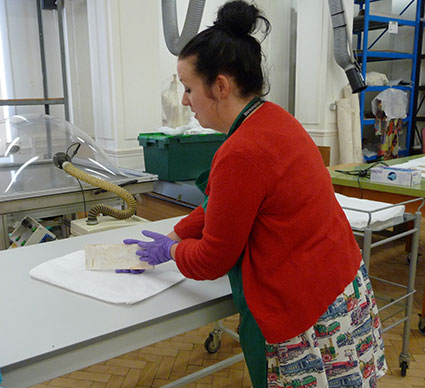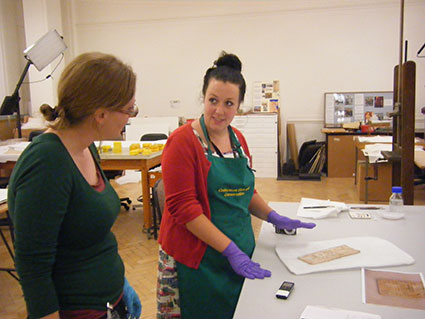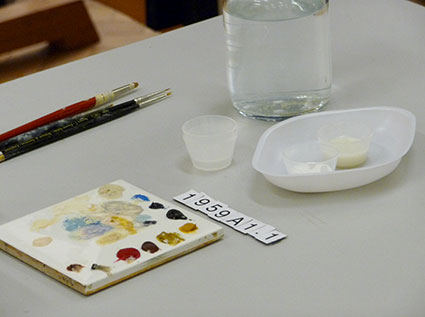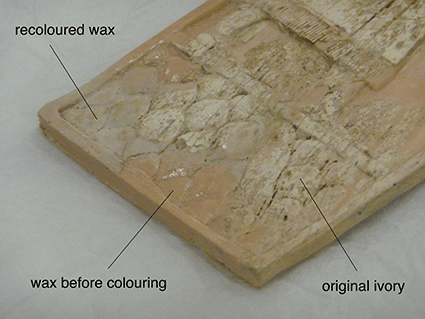Conserving Birmingham Museum's Nimrud ivories
When ivory carvings were found at Nimrud in the 1950s, Agatha Christie PGP used her face cream to clean them. But how do museums care for these 3000-year-old Assyrian artefacts today? In summer 2013 the Nimrud Project visited Birmingham Museum and Art Gallery to see how they care for their collection of Nimrud ivories TT . Conservator Alexandra Cantrill gave us a behind-the-scenes look at her conservation work and the processes used to preserve these objects for future generations.
In summer 2013, Birmingham Museum and Art Gallery carried out conservation TT work on their Nimrud ivories as part of a major gallery redisplay. Alex Cantrill, conservator TT at the museum, kindly invited Eleanor Robson and Ruth Horry from the Nimrud Project to see her work on the ivories in progress.
Alex is part of a team of conservators in Birmingham's Collections Care and Conservation department who are responsible for the museum's collections. We met Alex in the conservation studio, behind the scenes from the museum galleries. She had laid out a number of ivories in the studio, mid-way through her conservation work, especially for us to view.
From Nimrud to Birmingham
Birmingham's ivories are among thousands of carved ivory TT fragments discovered at Nimrud during excavations by the British School of Archaeology in Iraq TT (BSAI) in the 1950s-60s. In antiquity these carved ivory panels were attached to wooden furniture, though little of the wood now survives. The majority of the ivories had been found in the ruins of Fort Shalmaneser, king Shalmaneser III's royal arsenal TT . Furniture was found heaped up in huge piles within the arsenal building, likely the spoils of war accumulated during foreign conquests.
The BSAI gifted 28 ivories to Birmingham Museum in return for financial contributions to the digs. A number of these ivories have been on display continuously for the past 20 years. They are now being conserved as part of a larger redisplay of the museum's ancient archaeological collections.
Assessing the ivories using x-ray imaging
Alex told us about the initial stages of the conservation work, which she had been carrying out in the week before our visit. The first step was to assess the structural condition of the ivories. Assessment is important as there are few written records of any previous conservation work done on the objects. Conservation practices have changed greatly in last quarter-century, and while extensive records are now taken, there are very few records from before the 1990s. This is a general challenge when conserving museum objects, and the Nimrud ivories are no exception. Some Nimrud objects underwent cleaning in the field site, or were restored before being gifted to museums. Alex explained that while several of Birmingham's ivories have undergone restoration, there are no records of whether this was done before or after coming to Birmingham.
Alex takes x-ray images as part of the assessment, using the conservation department's digital x-ray machine. X-ray images are a useful tool in assessing condition as they reveal where an ivory has been assembled from individual fragments. Many ivories were discovered in a fragmentary state and joined together in the 1950s-60s. From the x-ray, Alex can assess the state of these old joins.
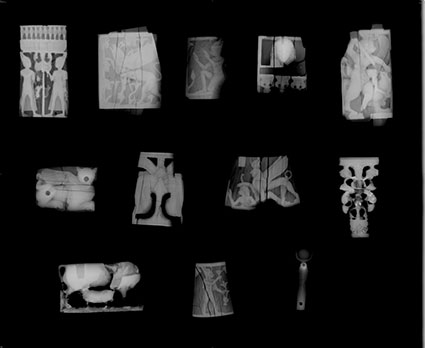
Conservation x-ray image of some of Birmingham's Nimrud ivories. X-ray taken at 50kv 120sec 3ma. View high quality version of image (623 KB) © Birmingham Museums.
X-ray imaging is especially useful for assessing any ivories with detached pieces, such as 1965A451.5 showing a figure holding a sword to a griffin TT (1). "The corner of this piece has come apart, and it's all quite fragmented", Alex explained. "I wanted to see what state the area is in, and to check if it's particularly weak elsewhere. If you're going to put these pieces back in place, you need to check it won't just fall apart elsewhere. But I feel confident that it should go together again quite nicely."
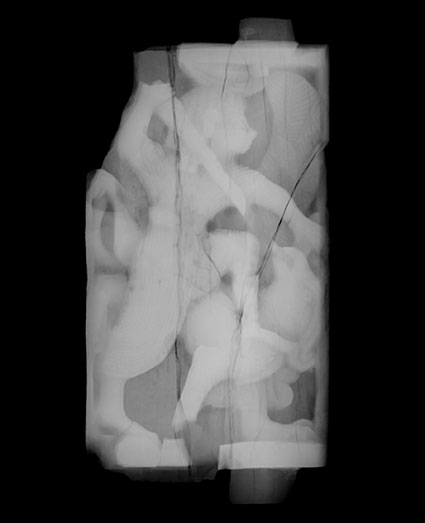
X-ray image of ivory 1965A451.5 showing several individually visible fragments. The fragments were likely assembled shortly after excavation in 1960-1. X-ray taken at 50kv 120sec 3ma. View high quality version of image (623 KB) © Birmingham Museums
The x-ray image of the ivories also reveals other information, such as traces of gold-coloured metallic overlay on the surface of ivory 1958A275, a stylised tree with flowers (2). "With this one, for example", Alex told us, "we could see that there is potentially metal pigment there, but this [x-ray] has confirmed it".
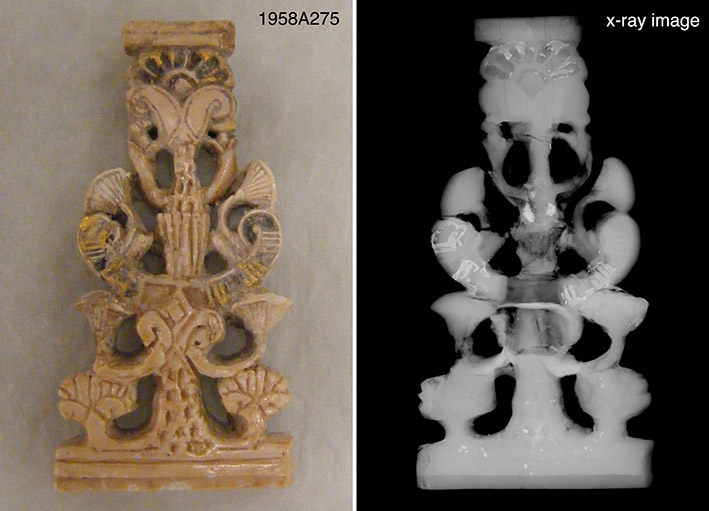
Ivory 1958A275 (left) and x-ray image (right). Traces of metallic overlay show up clearly on the x-ray. Photo: Birmingham Museum and Art Gallery Conservation Department. View larger version of image (273KB)
To determine exactly which metal was present, Alex analysed that area using a technique called x-ray fluorescence (XRF) spectroscopy. The XRF spectrograph uses x-ray radiation to determine the composition of any metal elements present. The results showed that the metal is predominantly gold. These traces are likely the remains of gold overlay decoration that once covered the carving's surface but was stripped away by looters in antiquity.
» Video demonstration of the XRF spectrograph by Birmingham's Staffordshire Hoard conservation staff (via Vimeo, length: 03:52)
Keeping records
Alex keeps extensive records of all assessments, condition reports, and treatments undertaken. Conservation work is carried out according to professional and ethical standards that ensure that cultural heritage TT is treated ethically and responsibly. Part of conservation ethics includes keeping a full record of all assessments carried out and any conservation procedures used, including details of the materials involved. Alex initially takes notes on her work by hand into a day book TT . When the work is complete, this is transcribed into the museum's collections database.
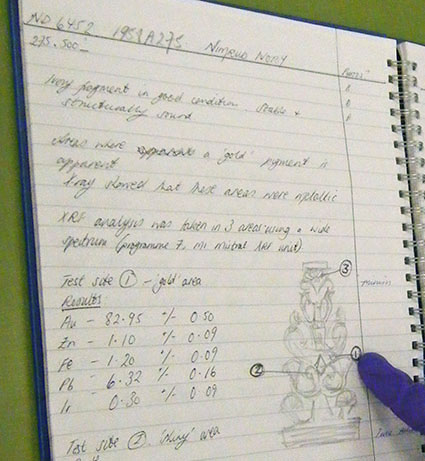
"Ivory fragment in good condition. Stable and structurally sound." Alex makes a detailed record of her assessment of ivory 1958A275.5 and records the results of XRF analysis.
Cleaning ivories
Alex explained the cleaning work she has been carrying out on the ivories, to remove dirt and other contaminants such as old coatings covering the surface. Cleaning is done under a microscope, gently using a dry brush to remove surface dirt. Wet cleaning is only done when necessary, using Industrial Methylated Spirits (IMS) a conservation grade solvent. Alex showed us one of the ivories that she had cleaned, number 1965A451.3, showing a framed female face. This artefact had been covered in a shiny varnish-like coating, though there are no records of whether this was done before or after arriving at Birmingham. Alex removed the old coating and has returned the ivory surface to a more natural state.
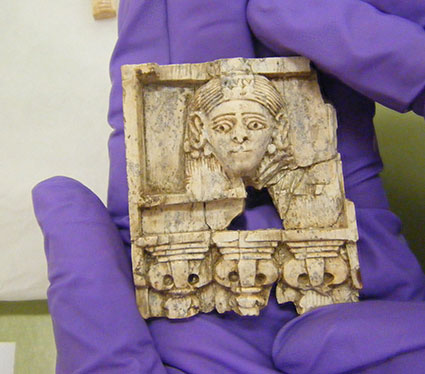
Newly cleaned ivory 1965A451.3. The surface was previously covered in an old shiny and "quite gelatinous TT " coating, which Alex removed during cleaning.
AUDIO: cleaning Nimrud ivories (00:59)
Transcript of conversation
"Generally, you get it under the microscope. I've been dry cleaning just to begin with, just with a dry brush. It always sounds a bit pathetic, but it's always amazing how much that works.
This [ivory], with a dry brush will clean up quite nicely. ... I've been trying to avoid anything wet really, which is the main thing with ivory. Where I've felt it would take a solvent of some sort I've used an IMS [Industrial Methylated Spirit]. And I've chosen that because of its chemical structure. The size of the molecules in IMS are larger to that in acetone, so if I used acetone it would probably penetrate deeper than I'd want it to. With IMS (Interviewer: what's IMS?) Industrial Methylated Spirit. It's a standard solvent that we use for cleaning. Using that, with the molecules being bigger, it's less likely to penetrate further than I want it to, and it disappears quickly off the surface. It doesn't hang about. So I've been using that, very sparingly, just where I needed to."
Download audio clip: MP3 format (718 KB) [/nimrud/downloads/bmag-nimrudivories-1.mp3] | OGG Vorbis format (709 KB) [/nimrud/downloads/bmag-nimrudivories-1.ogg]
Agatha's face cream?
Alex told us that Birmingham's ivories are generally in a good state, and previous cleaning doesn't appear to have damaged them. But emergency cleaning at the Nimrud field site in the 1950s was done only with materials to hand, with limited experience of how best to conserve such materials, and often without a professional conservator present. Famously, Agatha Christie PGP used her face cream to clean ivories coming out of the ground. We asked Alex for her thoughts on using face cream on the ivories, and how it might have affected them.
"It's something that we would never do ourselves but ... we can kind of see why it worked. Because it's quite thick and viscid TT , so it wouldn't necessarily penetrate into the ivory. But it would loosen things up a bit and help them clean it."
The question of whether Birmingham's ivories show traces of Agatha's face cream remains unanswered though. Alex's XRF analysis has shown traces of zinc on the surface of some ivories, which is a well known substance from face creams and hand creams. "But we don't know how much it's being thrown out by something else that might have been put on the surface," Alex explained. "So, I don't know. It's guesswork. It's just, I wonder!"
"Part of an object's journey"
Agatha's face cream may remain a mystery, but some old repairs to the ivories are much more visible. We also viewed Birmingham's ivory 1961A131, depicting a cow and its calf (3). The deep brown-black colour of the ivory was caused by being burned in antiquity as invaders set the buildings alight. Also immediately visible on this object was the large amount of reconstruction that had been done to it. The cow's legs have been reconstructed with a filler and the reverse is supported with a thick hardboard backing.
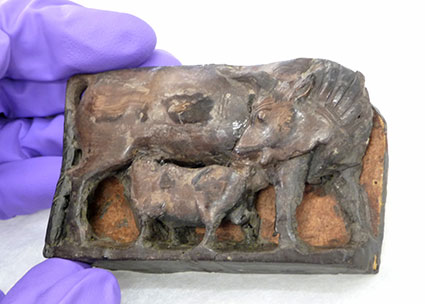
Front of ivory 1961A131, which was burned in antiquity, resulting in a deep brown-black colour. The cow's legs have been reconstructed with filler.
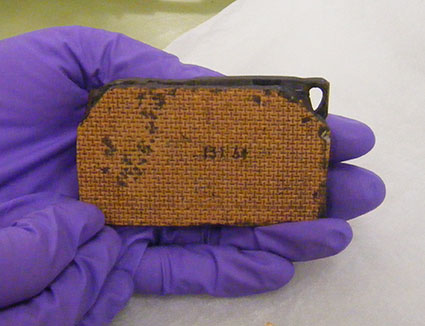
Reverse of ivory 1961A131. A thick hardboard backing was used to reconstruct the object in the 1960s-70s.
This type of extensive reconstruction would not be carried out today, as it would be considered too intrusive to the artefact. According to today's conservation standards, repairs should blend in with the object from a distance, yet should also still be visible when viewed up close. (This idea is sometimes referred to as the 'six-foot/six-inch rule'.) While the mid-twentieth century repairs are highly intrusive by today's standards, they are also now part of this object's history. Birmingham Museum has to take this into account when deciding whether to leave old repairs in place or remove them. We asked Alex about how the museum would go about making such a decision, thinking about the burned cow as an example. "That's a conversation that would happen with a curator," she explained. She would discuss the ivories with Adam Jaffer, Curator of World Cultures, who is responsible for this collection. "And the conversation wouldn't just be 'let's talk about this for 10 minutes', it would likely be a lot of pros and cons. What would intervening do for the object? What would it do for anything else?"
As to whether she would consider removing the repairs from the burned cow 1961A131, Alex said "I'd be very dubious about that one. With some more analysis I'd be able to see exactly where the original object and fill materials join. But this newer material is now so part of the object that taking away the hardboard would almost be like taking away part of its journey."
Sensitive recolouring
Alex's work on ivory 1959A1.1 (4) also illustrates how ethics have changed regarding the visibility of reconstruction. In the mid-twentieth century this ivory was reconstructed using a pink-coloured wax, possibly standard dental wax, and the pink colour stands out distinctly from the original parts of the ivory. The colour and texture difference is now considered too intrusive and the museum will sensitively tone it down before putting the object back on display.
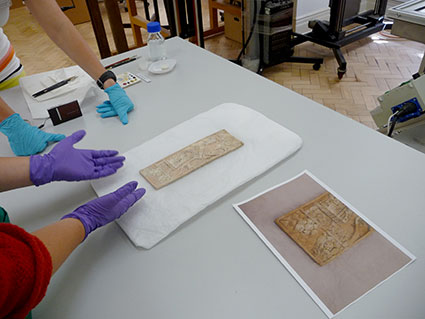
Alex shows us ivory 1959A1.1, which has old wax reconstructions. Photographs show the artefact before recolouring begins.
Alex tells us how she is currently midway through toning down the pink colour. First she applies a barrier layer over the surface of the wax, using Paraloid B72 (ethyl methacrylate copolymer) dissolved in a 20% solution with acetone TT . The barrier layer ensures that the paint can be removed if needed. Reversibility of treatment is also an essential part of conservation ethics. Then she uses conservation grade acrylic paint TT to recolour the wax to fit in more closely with the natural ivory, but which is still distinguishable as a reconstruction.
AUDIO: recolouring old wax reconstructions (01:13)
Transcript of conversation
"This was a discussion about whether or not to re-touch-in the wax, to make it a bit less pink. And again, that was a conversation with the curator where we decided that, yes, that would be quite a good thing to do.
That's a conversation where it's more about the aesthetics of the piece. It's to allow the object to be read better. As in, because, the first thing you see is the pink. (Interviewer: the pink shine). Yes. Because when you look at it you just see lots of pink stuff.
So, in this corner here I've started, and down here. [Alex shows us the ivory] ... You can see where it's shiny. So that's working with our conservation ethics. That's a reversible base layer that I know I can easily remove without doing any harm. And it puts a barrier layer between the original material, even though we're saying the 'original' material is dental wax. So then it protects what's originally there, and then we can just touch it in with some paint.
Again, with the conservation ethics, we have to, when we're doing a re-touch like that, we have to keep it different enough so that you can tell that it's not original, so we're not trying to fool the viewer. So it's more about you being able to get an idea of what the object is."
Download audio clip: MP3 format (882 KB) [/nimrud/downloads/bmag-nimrudivories-2.mp3] | OGG Vorbis format (880 KB) [/nimrud/downloads/bmag-nimrudivories-2.ogg]
Redisplaying the ivories
When Alex's conservation work on the ivories is complete, the ivories will go back on display in a different gallery as part of a larger redisplay of collections. The ivories will move into new display cases and temperature and humidity TT will be carefully controlled. Humidity sensors are placed in the cases, allowing the collections care team to monitor and respond to any changes.
Alex also has to consider the amount of light that the ivories will be exposed to while on display, ensuring the level falls below the agreed standard for ivory objects. The decision on how best to display these objects was jointly discussed by the curators and conservation department. As light levels in the chosen gallery are difficult to control, Alex explained, "There will be a cloth that you'll have to lift up to look at them". This will ensure that the fragile ivories are not damaged by light exposure over time and can be enjoyed by museum visitors for generations to come.
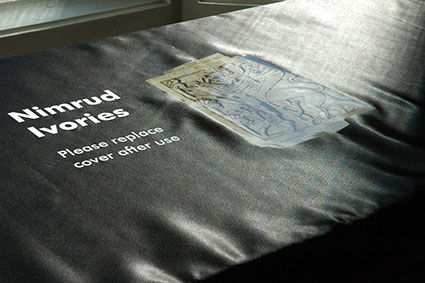
Light-proof cloth cover on the Nimrud ivories display case. © Birmingham Museums
March 2014 update: Ivories back on display
As of March 2014, conservation work is complete and the Nimrud ivories are now back on display at Birmingham Museum and Art Gallery in Gallery 35. Curator Adam Jaffer has redisplayed them in their original museum case, with the addition of a lift-up cover to protect them. Conservation and redisplay work has ensured that Birmingham's Nimrud ivories are preserved for present and future museum visitors to enjoy.
» View image of newly-conserved ivory 1965A451.2, depicting a winged griffin.
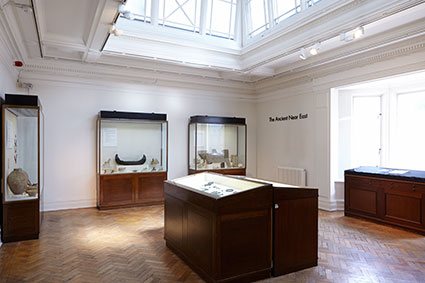
Ancient Near East Gallery 35, photographed in April 2014. Nimrud ivories are in the display case to the right. View large image (97 KB). © Birmingham Museums.
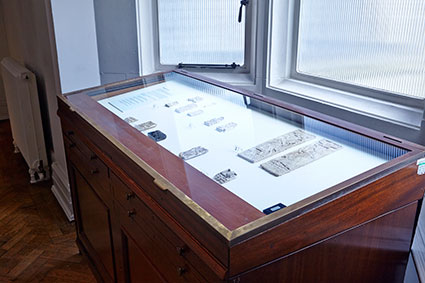
Newly-conserved Nimrud ivories back on display in Gallery 35, April 2014. Environmental conditions are monitored using sensors inside the case (bottom right). View large image (81 KB). © Birmingham Museums
The Nimrud Project is grateful to Alex Cantrill, Pieta Greaves and Adam Jaffer for a fascinating behind-the-scenes view of Birmingham's conservation work.
» Read more about conservation work at Birmingham Museum and Art Gallery in the Staffordshire Hoard Conservation and Research blog.
Content last modified: 18 Dec 2019.
References
- , pp. 15, 18, 105. (Find in text ^)
- , p. 131. (Find in text ^)
- , pp. 70, plate 28. (Find in text ^)
- Mallowan, M.E.L. and G. Herrmann, 1974. Furniture from SW 7, Fort Shalmaneser (Ivories from Nimrud III), London: British School of Archaeology in Iraq (free PDF from BISI, 22 MB), pp. 95-96, plate LXVI. (Find in text ^)
Ruth A. Horry
Ruth A. Horry, 'Conserving Birmingham Museum's Nimrud ivories', Nimrud: Materialities of Assyrian Knowledge Production, The Nimrud Project at Oracc.org, 2019 [http://oracc.museum.upenn.edu/nimrud/modernnimrud/atthemuseum/conservingnimrudivories/]
